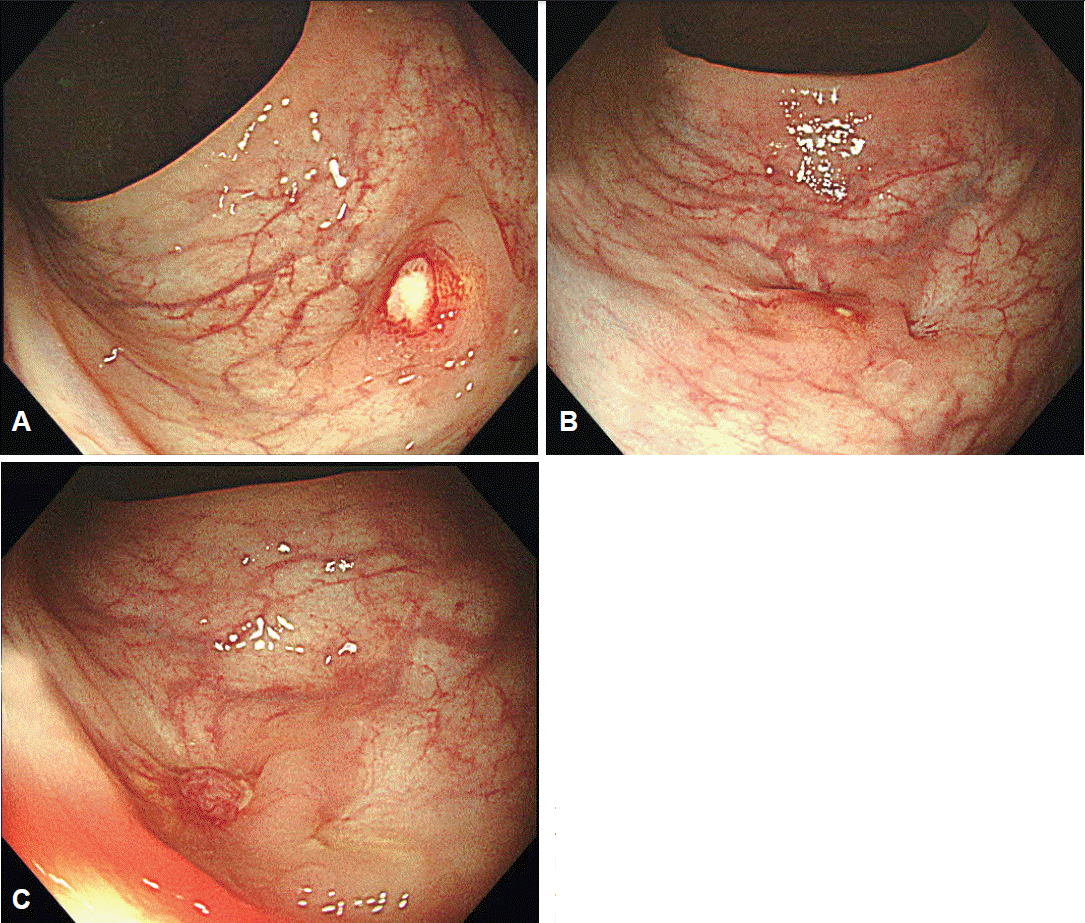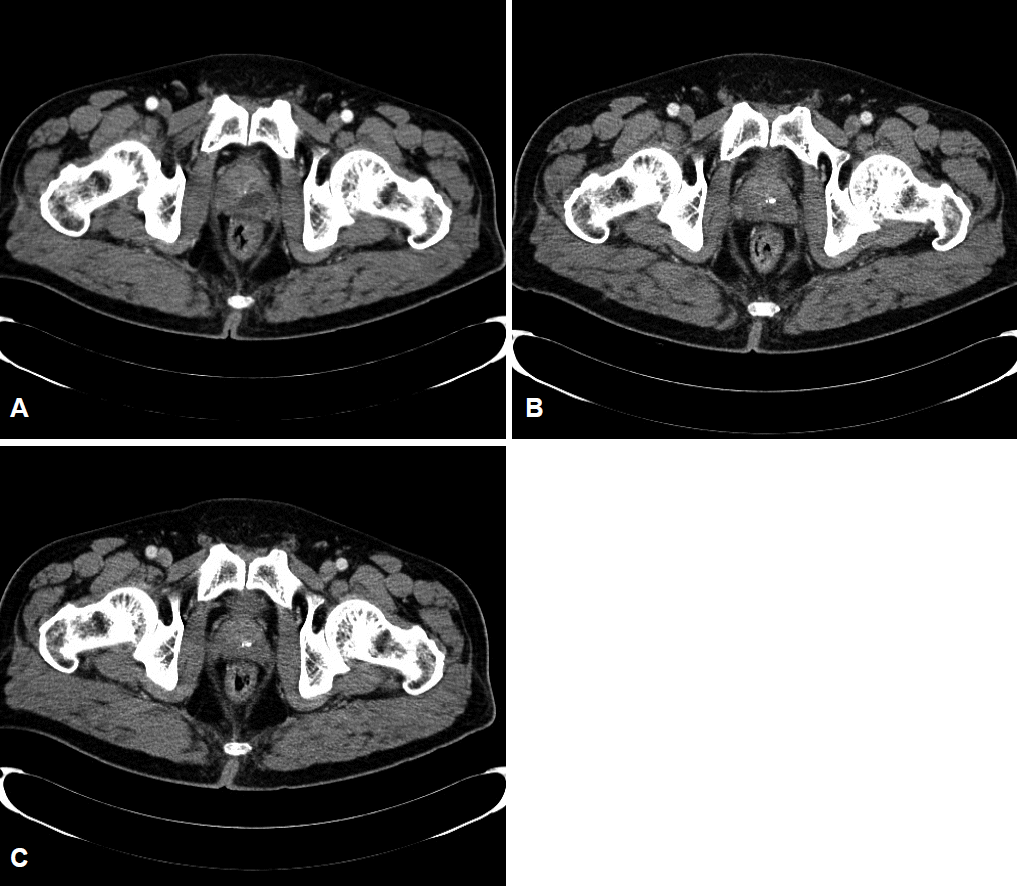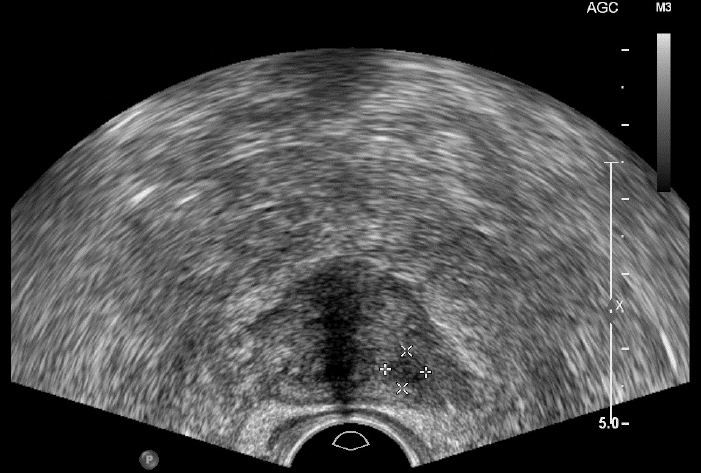INTRODUCTION
Bacillus Calmette-GuУЉrin (BCG) has been commonly used as a vaccine against tuberculous infection. Intravesical BCG immunotherapy after transurethral resection for bladder tumor (TUR-BT) has been used to treat bladder cancer [1]. This therapy is generally safe. It has a rare complication of tuberculous infection within the prostate [2]. The complication of tuberculous prostatic abscess with prostatorectal fistula is extremely rare. Reported herein is a case of tuberculous prostatic abscess with prostatorectal fistula after intravesical BCG immunotherapy, which was successfully treated with antitubercular drugs.
CASE REPORT
A 61-year-old man presented himself to the gastroenterology department of the authorsт hospital with a 1-month history of lower abdominal pain. Colonoscopy was performed to evaluate the abdominal pain, and a 6-mm rectal ulcer located on the anterior wall of the prostate, combined with a possible fistula tract, was observed (Fig. 1A). A biopsy of the rectal ulcer was taken for histopathological examination. The biopsy showed chronic granulomatous inflammation with caseation necrosis, consistent with tuberculosis (Fig. 2A). The biopsy specimen was positive for tuberculosis by polymerase chain reaction (TB-PCR).
The patient had undergone TUR-BT for a stage T1 bladder tumor 7 months ago. He had pulmonary tuberculosis when he was young, for which he had not had any treatment. A chest radiograph revealed signs of prior pulmonary tuberculosis. Intravesical BCG (12.5 mg in 50 mL normal saline, Oncotice; MSD, Kenilworth, NJ USA) immunotherapy was performed once a week for 6 weeks. There was no other significant medical history.
The rectal examination revealed an enlarged prostate, and no fistulous opening could be palpated. The microscopic urinalysis showed few leukocytes and few red blood cells. The urine was negative for acid-fast bacteria (AFB). The total prostate-specific antigen (PSA) was 2.7 ng/mL, and the free PSA was 0.33 ng/mL. An abdominopelvic computed tomography (CT) showed an approximately 3.3 cm hypodense lesion in the left prostate gland as well as adjacent mild wall thickening at the anterior wall of the distal rectum (Fig. 3A). Based on these findings, a diagnosis of prostatorectal fistula was made. The patient was treated with isoniazid (300 mg/day), rifampicin (600 mg/day), ethambutol (800 mg/day), and pyrazinamide (1Т 500 mg/day) for 2 months, followed by isoniazid (300 mg/day), rifampicin (600 mg/day), and ethambutol (800 mg/day) for 7 months.
Transrectal ultrasonography was done a month after initiating the antitubercular therapy, and it showed a small hypoechoic lesion on the apical wall as well as a healed fistulous tract (Fig. 4). After 6 months of therapy, a follow-up colonoscopy was done, which showed a persistent ulcer but with an improved condition (Fig. 1B). A biopsy of the ulcer was taken. The biopsy specimen was negative for AFB but was positive for TB-PCR, and the biopsy still showed chronic granulomatous inflammation with caseation necrosis (Fig. 2B). The abdominopelvic CT showed an approximately 2-cm hypodense lesion in the left prostate gland (Fig. 3B). The antitubercular therapy was continued for an additional 3 months. After completion of the 9-month regimen of antitubercular therapy, a follow-up colonoscopy was performed, which showed the disappearance of the rectal ulcer (Fig. 1C). The biopsy specimen from the site of the former ulcer was negative for TB-PCR, and the biopsy showed the disappearance of the caseation necrosis (Fig. 2C). The abdominopelvic CT also showed the disappearance of the hypodense lesion in the left prostate gland (Fig. 3C). The patientтs latest cystoscopy showed no evidence of the prostatic abscess or fistula.
DISCUSSION
BCG has been commonly used as a vaccine for tuberculous infection. Furthermore, intravesical BCG immunotherapy after TUR-BT has been used for bladder cancer treatment. It was first used in 1976 as a non-specific immunostimulant [3]. This therapy is generally safe, but it has a rare complication of tuberculous infection within the prostate, which can occur via hematogenous spread and through the direct extension of the infection [4]. The direct extension of tuberculosis from the bladder may cause a prostatic abscess. Lamm et al. [5] reviewed 1Т 278 cases of bladder cancer treated with intravesical BCG immunotherapy and found that localized BCG infection was a rare complication. Its incidence rate is unknown, but tuberculous prostatic abscess with prostatorectal fistula is rarely reported and may be an extremely rare complication. This is because of the fascia located between the prostate and the rectum, which usually prevents fistula formation [6].
Transurethral or transperineal drainage with 9 to 12 months of antitubercular treatment has been used as a tubercular prostatic abscess treatment modality [7,8]. To the authorsт knowledge, only five cases of prostate abscesses have been reported, of which three cases were treated with transurethral drainage [2,7,9], one with transperineal drainage [8], and one with only antitubercular drugs [10]. Because the prostate abscess was small in the caseТ presented herein, drainage was not performed, and the patient was treated only with antitubercular drugs. A follow-up abdominopelvic CT showed a completely healed prostatic abscess and fistula after 9 months of antitubercular treatment.
This is only the second report of a tuberculous prostatic abscess with prostatorectal fistula after BCG immunotherapy in the world, and the first report from South Korea. In the first-ever report of this complication, the patient was treated with transurethral drainage and antitubercular drugs [9]. In the caseТ presented herein, the patient was successfully treated with only antitubercular drugs. The results of this case indicate that conservative treatment with antitubercular drugs may be useful in treating tuberculous prostatic abscesses with prostatorectal fistulas. A larger-scale study will be needed for confirmation of this treatmentтs efficacy and safety.
In summary, tuberculous prostatic abscess with prostatorectal fistula is a very rare complication and the patient was successfully treated with antitubercular drugs only.










